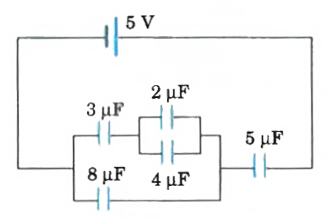A capacitor charged to 50V is discharged by connecting the two plates at t=0.If the potential difference across the plates drops to 1.0 V at t=10 ms,what will be the potential difference at t=20 ms?
The potential difference at time t is given by
V=Q/C=(Q0/C)e−t/RC.
or,V=V0e−t/RC
Acorrding to the given data,
1V=(50V)e−10ms/RC
or,e−10ms/RC=150.
The potential dofference at t-20 ms is
V=V0e−t/RC
(50V)e^(-20ms//RC)=(50V)(e^(-10ms//RC))^(2).<br>0.02V.
Topper's Solved these Questions
- ELECTRIC CURRENT IN CONDUCTORSBOOK - HC VERMACHAPTER - ELECTRIC CURRENT IN CONDUCTORSEXERCISE - worked out Example
1 Video
- ELECTRIC CURRENT IN CONDUCTORSBOOK - HC VERMACHAPTER - ELECTRIC CURRENT IN CONDUCTORSEXERCISE - Short Answer
17 Videos
- ELECTRIC CURRENT IN CONDUCTORSBOOK - HC VERMACHAPTER - ELECTRIC CURRENT IN CONDUCTORSEXERCISE - Exercises
84 Videos
- DISPERSION AND SPECTRABOOK - HC VERMACHAPTER - DISPERSION AND SPECTRAEXERCISE - Exercises
11 Videos
- ELECTRIC CURRENT THROUGH GASESBOOK - HC VERMACHAPTER - ELECTRIC CURRENT THROUGH GASESEXERCISE - Exercises
23 Videos
Similar Questions
A capacitor charged to 100V is discharged by connecting the two ptates at t=0 . If the potential difference across the plates drops to 1.0V at 10ms, what will be the potential difference at t=20ms.
View SolutionThe charge stored in a capacitor is 20μ C and the potential difference across the plates is 500V .Its capacity is ..?
View Solution
Knowledge Check
A capacitor is charged to a potential difference of 100 V and is then connected across a resistor. The potential difference across the capacitor decays exponentially with respect to time. After 1 sec, the P.D. between the plates of the capacitor is 80 V. what will be the potential difference between the plates after 2 sec ?
AAfter 2ms from start, the potential difference across the resistor is 64 VBAfter 2ms from start, the potential difference across the capacitor is 64 VCAfter 2ms from start , the potential difference across the resistor is 60VDAfter 2ms from start , the potential difference across the capacitor is 60 VThe plates of a capacitor are charged to a potential difference of 320 volt and are then connected across a resistor. The potential difference across the capacitor decays exponentially with time. After 1 sec the potential difference between the plates of the capacitor is 240 volts. what is the potential difference between the plates after 2 s?
A200 VB180 VC160 VD140 V
A capacitor with an initial potential difference of 80.0 V is discharged through a resistor when a switch between them is closed at t=0. At t= 10.0s, the potential difference across the capacitor is 1.00V (a) What is time constant of the circuit? (b) What is the potential difference across the capacilor
View SolutionThe plates of a parallel plate capacitor are charged to a potential difference of 117 V and then connected across a resistor. The potential difference across the capacitor decreases exponentially with to time. After 1s the potential difference between the plates is 39 V, then after 2s from the start, the potential difference (in V) between the plates is
View SolutionA 100pF capacitor is charged to a potential difference of 80.0V and the charging battery is disconnected. The capacitor is then connected in parallel with a second capacitor. If the potential difference across the first capacitor drops to 35.0 V what is the capacitance of this second capacitor?
View SolutionFive capacitors are connected across a battery of 5V as shown in figure (o). Calculate the potential difference across the plates of the 5μF capacitor.

View SolutionThe plates of a parallel plate capacitor are charged to a potential difference of 117 V and then connected across a resistor. The potential difference across the capacitor decreases exponentially with to time. After 1s the potential difference between the plates is 39 V, then after 2s from the start, the potential difference (in V) between the plates is
View SolutionThe plates of capacitor are charged to a potential difference of 100V and then connected across a resistor.When the potential difference between the plates of the capacitor is 60V ,what is the fraction of the stored energy which has been dissipated?
View Solution
